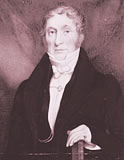William Redfern facts for kids
William Redfern (born 1774 – died 17 July 1833) was an important surgeon in early Australia. He grew up in England. William Redfern was sent to New South Wales as a convict. This happened because of his part in a big protest by sailors called the Nore mutiny. Many people think of him as the "father of Australian medicine."
Contents
Early Life and Training
William Redfern was born in County Antrim, Ireland. He grew up in Trowbridge, Wiltshire, England. He learned about medicine by working as an apprentice for his older brother, Thomas. In 1797, he passed an important exam from the London Company of Surgeons. After that, he became a surgeon's mate on a large ship called HMS Standard.
The Nore Mutiny
In 1797, William Redfern was on the ship Standard. The sailors on many ships, including his, protested against their officers. This event was known as the Nore mutiny. Because of his involvement, Redfern faced a very serious punishment. However, the court decided to be merciful because he was a surgeon. His punishment was changed to being imprisoned for life.
William Redfern then asked to be sent to New South Wales. After spending four years in jails in England, he was sent to Australia in 1801.
Starting a New Life on Norfolk Island
When William Redfern arrived in Sydney, he was given a special kind of freedom called a conditional pardon. This meant he was still a convict but had more freedom. He was then sent to Norfolk Island. There, he worked as an assistant surgeon for the new colony.
On June 19, 1803, the colony's governor, Philip Gidley King, gave him a full pardon. This meant he was no longer considered a convict. Even with the full pardon, he stayed on Norfolk Island as an assistant surgeon. He worked there from May 1802 until 1808. Then, he returned to Sydney.
Medical Work in New South Wales
As early as 1804, William Redfern started to support using a new smallpox vaccine. This vaccine helped protect people from the dangerous smallpox disease. The Surgeon-General of New South Wales, Thomas Jamison, checked Redfern's medical knowledge. He confirmed that Redfern was "qualified to exercise the profession of a surgeon."
In 1808, William Redfern returned to Sydney. Governor Joseph Foveaux appointed him as an assistant surgeon for the new Sydney Hospital. Governor Foveaux believed Redfern's "skill and ability in his profession are unquestionable." He also said Redfern's behavior deserved "particular approbation," meaning high praise.
Working with Governor Macquarie
William Redfern's standing became even better when Governor Lachlan Macquarie arrived in 1810. Governor Macquarie wanted to help former convicts who had behaved well. He believed that if former convicts showed good conduct, they should be able to return to a respected place in society. Redfern was one of only four former convicts whom Macquarie invited to his own table. This showed how much Macquarie respected him.
In 1814, Redfern wrote a report for Governor Macquarie. This report was about the unhealthy conditions on ships that brought convicts to New South Wales. Because of his report, the conditions on these ships greatly improved. In 1817, he helped start the Bank of New South Wales. In 1811, he married Sarah Spencer Wills.
Later Career and Retirement
William Redfern hoped to become the main surgeon after D'Arcy Wentworth. Governor Macquarie even suggested him for the job in 1818. However, the position was given to James Bowman in 1819. Redfern then left the Colonial Medical Service.
Later that same year, Governor Macquarie made Redfern a magistrate. A magistrate is a type of judge. But this appointment was not approved by Commissioner Bigge. Redfern had a very busy private medical practice. Even though he could be a bit direct, people liked and trusted him a lot. He became the "best" and "best-known" surgeon in Sydney.
In 1821, he visited England. He went as a representative for former convicts. He tried to help them get rid of some legal problems. These problems came from a court decision in London. His efforts helped lead to the New South Wales Act 1823. This law allowed former prisoners who had served their time to own property and take legal action.
In January 1824, he was on the island of Madeira to improve his health. His wife, who was in London, asked for more land for him. This request was approved. By this time, he was doing very well financially. In 1826, he stopped working as a doctor. For about two years, he focused on scientific farming. This had been a hobby of his for a while.
Death
Around the end of 1828, William Redfern went to Edinburgh, Scotland. He went there to bring his son, William Lachlan Macquarie Redfern, for his education. William Redfern died in Edinburgh in July 1833.
Legacy
The suburb of Redfern, New South Wales in Australia is named after him. This area developed on land that he used to own.
A detailed two-volume book about his life was written by Arthur Jones and published in 2019.
See also
- List of convicts transported to Australia


